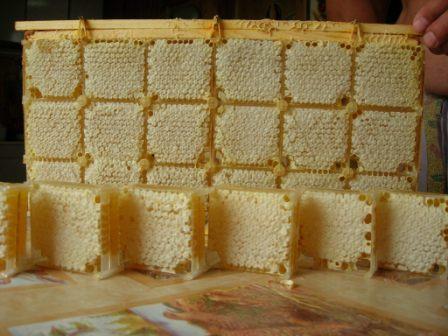Medicinal properties of acacia honey

Acacia honey benefits the body. What are the reasons for the healing properties of acacia honey? The medicinal properties of acacia honey are determined by the fact that the nectar from acacia flowers contains medicinal forms similar to those contained in the flowers themselves. Flower pollen grains get into honey. The healing properties of acacia honey are enhanced by bee enzymes, which bees add to honey when processing nectar. White acacia flowers are considered medicinal due to the content of essential oils, which include salicylic acid ester, robinia glycoside, sugar flavonoids, and organic acids.
Thanks to its composition, acacia honey calms the nervous system; it is useful to use it before bed for insomnia. It will help with diseases of the stomach and digestive system, and eye diseases. Experiments show that it can be used for colds and many other diseases. Science has yet to study all the beneficial properties of acacia honey.
In general, honey from white acacia is simply very tasty.
Acacia honey for children
Is it possible to give acacia honey to children? Acacia honey can be given to children, it tastes sweet and does not cause allergies, children really like it. The only thing is that you should not give honey to children under 1 year old.
Is it possible to drink acacia honey during pregnancy?
Can pregnant women consume acacia honey?
White acacia honey has a large range of vitamins, so it can definitely be recommended to women during Pregnancy. Honey will help strengthen the body during seasonal colds. Acacia honey can be a good alternative to sugar so that a woman can treat herself to sweets and not be afraid of an increase in blood sugar. Honey does not cause allergies. The main thing is to know the limits, how much honey you can eat in one day.
Recipes for treatment with acacia honey
Acacia honey is often used in folk medicine to treat various diseases. There are many recipes for using honey, mainly for the treatment of colds, for the treatment of eye diseases, diseases of the gastrointestinal tract, as a general tonic and sedative.
However, we must remember that you cannot self-medicate. If you are sick, you should consult a doctor, and use honey and other bee products only as an additional means of treatment.
Treating colds with acacia honey
Acacia honey is widely used to treat colds. There is evidence that acacia honey can help with apnea and asthma, but this has not yet been studied by official science.
Acacia honey can be used for sinusitis and sinusitis by making a compress of honey, boiled water and alcohol in proportion 3.2.1.
A compress is applied to the sinuses of the nose, covered with a woolen scarf and the compress is kept for several hours, or overnight, which will help relieve pain, swelling and improve the general condition of the patient.
For asthma, inhalation of a 30 percent aqueous solution of acacia honey is used.
Acacia honey for oncology
Medical studies have shown that acacia honey inhibits cell proliferation, delays the G0/G1 phase, stimulates cytokines, calcium ion release, and suppresses the expression of p53 and Bcl-2 in a dose-dependent manner.
Has a preventive effect against various diseases such as cancer 5,7-dihydroxyflavone, a natural flavone commonly found in acacia honey, is a potent anticancer agent, according to research. In studies examining the antiproliferative role of honey in human and mouse melanoma cell lines, it was found that acacia honey induces antiproliferative effects on melanoma cells in a dose- and time-dependent manner. As a result, it is possible that in the future, medicines for the prevention and treatment of cancer will be created based on acacia honey.
Acacia honey for eye diseases

Photo of comb honey from acacia - you can purchase a sealed frame of honey or several small sealed frames of honey
Acacia honey for the eyes is used in folk medicine. Traditional medicine advises diluting acacia honey in warm water in a ratio of 1:2 and using it as drops and lotions. For eye diseases such as conjunctivitis, keratitis, blepharitis, ulcers on the cornea, chemical and thermal burns of the eyes.
Official medicine, based on experience, recognizes that acacia honey is beneficial for the eyes and is a potential basis for the creation in the near future of a pharmaceutical eye drop based on acacia honey for the treatment of corneal abrasion.
Traditional medicine advises that acacia honey for the eyes should be used from honeycombs and therefore, to treat eye diseases with acacia honey, it is advisable to negotiate with a beekeeper and buy acacia honey from white acacia immediately in a frame that is completely sealed by bees. This is easy to do for beekeepers who produce sectional comb honey. In this case, acacia honey is the most beneficial for the eyes, the honey does not come into contact with air, with a honey extractor, with containers, etc., the honey remains It appears pure, retaining all its active properties. Honey in combs is stored for a very long time for a year or more; as needed, several cells are unsealed and acacia honey for the eyes is taken for instillation or for making lotions. To treat eyes, acacia honey is diluted in warm water in a ratio of 1:2, and then used for lotions and instillation.
Acacia honey for diseases of the liver, gastrointestinal tract and kidneys
Traditional medicine recommends using acacia honey for peptic ulcers of the stomach and duodenum. Dissolve acacia honey in warm water, take 1–2 hours before breakfast, lunch and 3 hours after dinner. In addition, you can add 40–60 drops of 5% propolis tincture to 1/4 glass of warm water or milk and drink it with honey water.
To reduce the secretory function of the stomach. Stir a tablespoon of acacia honey in a glass of milk or kefir and consume in the morning 1.5 hours before meals. If taken immediately before meals, it, on the contrary, promotes the secretion of gastric juice.
Acacia honey for skin diseases
Acacia honey can also be used successfully for skin conditions and wound treatment as it kills bacteria such as staphylococcus (Staphylococcus), streptococcus (Streptococcus) and gas gangrene (Clostridium perfringens).
